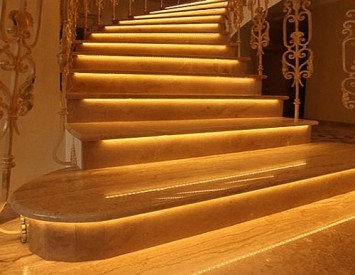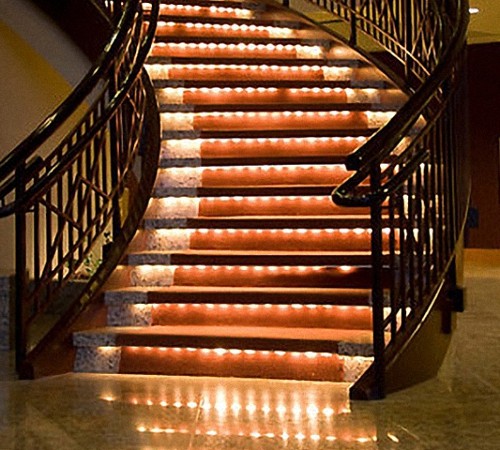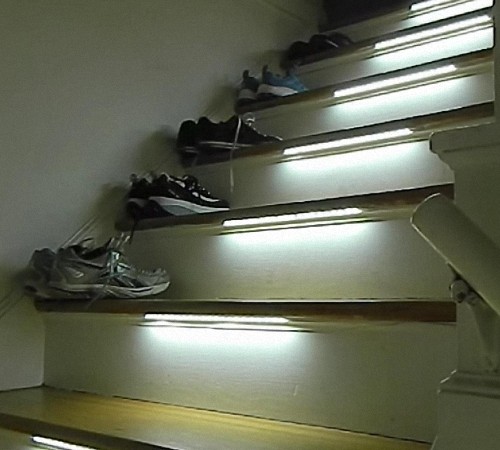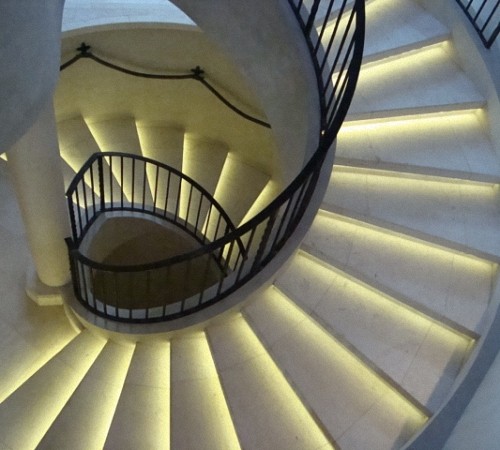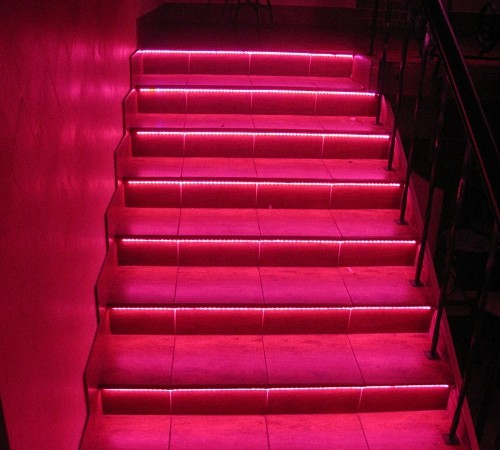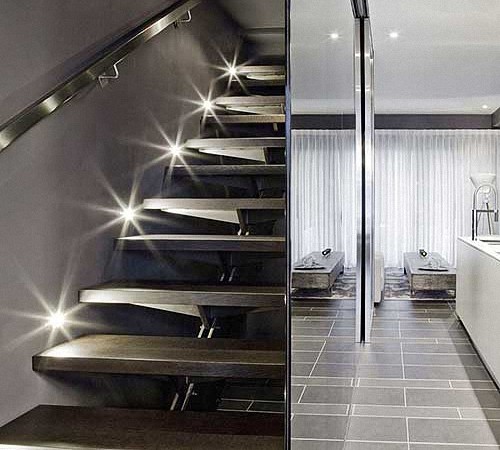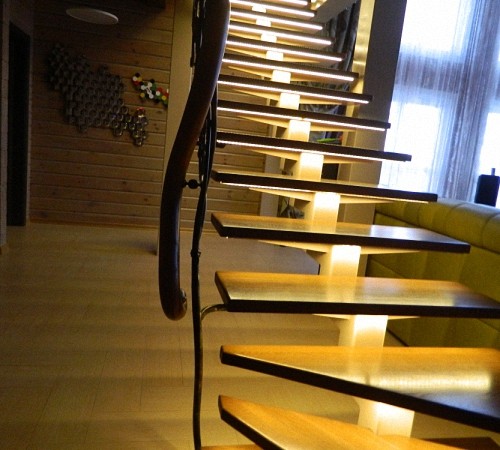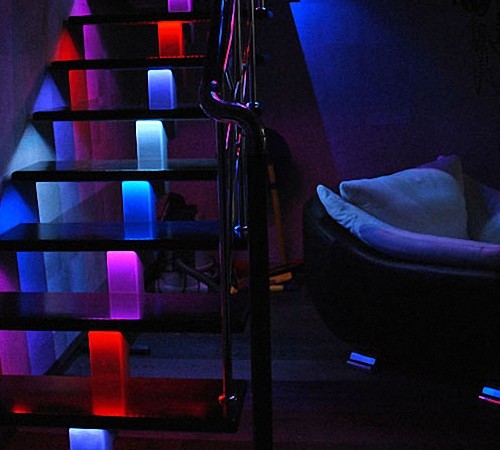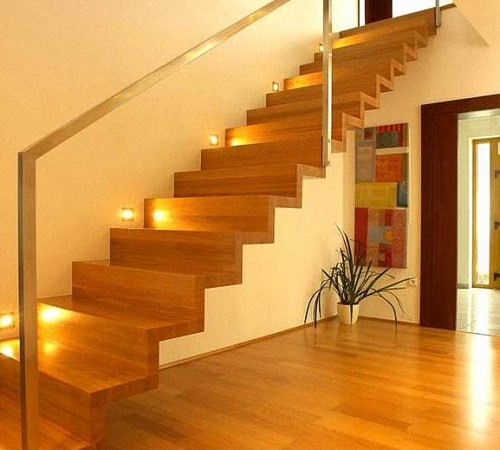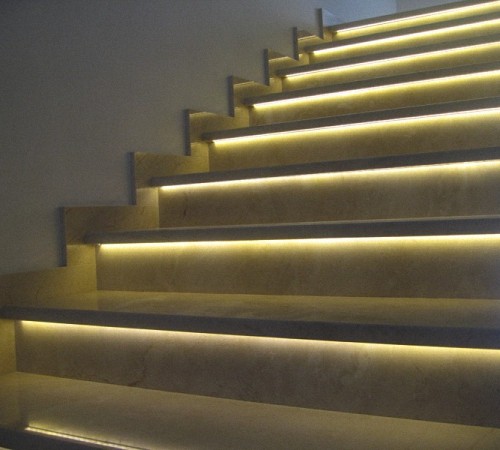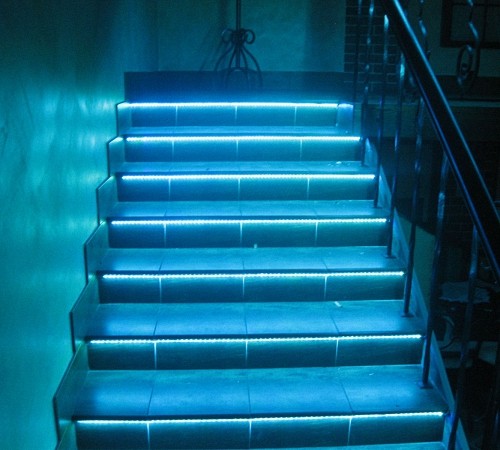The staircase in the house is not only a convenient way to climb the upper floors, but also an important element of the interior. However, familiarization with any room at the top can be unsafe if the stairs are close and uncomfortable, without handrails or poorly lit. The backlighting of the stairs in the house is especially important if it is located inside the building, has no natural light during the day, and evening light enters the opening space of both above and below. Today there are many solutions for lighting stairs, including very original methods, for example, automatic stairs illumination.
Content
What is the backlight of the stairs for?
The staircase in the house can become almost the main decorative element. There are several types of their design, and each of them involves its own type of lighting. But the most pleasant thing is a “smart house”, when the backlighting of the stairs with the motion sensor is built -in or there is equipment with a system of gradual turning on/off the steps. It works when someone uses them, and the steps from below or from above gradually turn on and off. The staircase can be lit in different places:
- on the railing;
- under the steps;
- under the ceiling;
- on the walls pointwise;
- combined way.
In addition to the aesthetic component, the efficiency of lighting is also important. Of course, you can set the time relay for the inclusion of light in Vespers time when the house has the greatest movement, for example, from 18.00 to 22.30. During this period, the whole family moves most of all around the house. The rest of the time, the lighting of the stairs can be adjusted in manual mode - a conventional switch. You can also use spotlights at the level of the railing, which are turned on from contact, or LED backlighting of the stairs with a special ribbon fixed under the ceiling or along the steps.
The safety element is no less important when arranging stairs, especially when its steps are made of smooth materials. They seem slippery, especially after washing the floors. Confident movement on the stairs is important for:
- old people with limited activity,
- people weakened by the disease;
- children who like to run the stairs.
Operation safety increases when ensuring the backlighting of the stairs by LED ribbon or designing lamps built in its steps. Do not forget about the reserve lighting source, for example, if the general electric shock is suddenly disconnected. A small bulb in the center of the stairs can be powered from a conventional automobile battery.
Whatever the choice, it is important that the backlighting of the stairs:
- it looked organic in the general design of the house;
- was economical;
- provided safe movement at any time of the day.
Tip: Remember that with any type of lighting on the stairs, in the first place will be not designer techniques, but to prevent traumatic situations when using steps. A good staircase - when it has a convenient interval between the steps, is equipped with handrails and a cover that levels slippery surfaces.
Varieties of stairs
1. Stairs were originally made only of wood (internal) and stone (external), and today these materials are used in the decoration of stairs to create comfort. In some interior styles, wood is indispensable, for example, country, eco -style, shawl, ethnic, etc. For the wooden structure of the stairs, a solid wood breed is used, which will ensure reliable operation for many years.
However, do not forget that any wood is a fire hazardous material, so it is important to think over the backlight in order to protect the house from a possible spark when the network is closed. The wood of the stairs should be treated with a special composition, counteracting combustion. It is necessary to process not only the location of the electrical equipment, but also all the wooden parts - the railing, balusters, decorative threads, etc.
2. Stairs made of glass look unusual, and weightless steps seem to soar in the air, but they are not suitable for people prone to dizziness. Such designs decorate the interiors in techno-stylistic or high-tech, often they are complemented by elegant metal structures. Modern interior design involves light materials:
- metal;
- glass;
- plastic;
- other synthetic materials.
The most convenient way is to hide the wires from backlight in decorative elements, for example, under handrails - against the background of glass or plastic, they will not be visible. But remember that many types of plastic are not only susceptible to combustion, but can also distinguish harmful substances during fire. All fire safety measures should be taken into account when installing these incredible glass products.
3. The classic staircase can be whole, if these are ready -made staircases, and you can also purchase collapsible wooden structures. Ready -made spans are easiest to mount and illuminate, and this type of stairs is most safe in terms of fire safety. It can be decorated with any finishing materials, and the wires from the backlight and sensors are easily masked with wild stone or other decorative tiles.
The steps of the thorough staircase can be made of solid stoves of natural stone: granite, marble, quartzite, shellout, etc. The backlighting method should favorably emphasize the nobility of the texture of natural materials. It will not be difficult to hide the equipment in this design, for example, you can fix thin neon lamps from below under each step. They can turn on from motion sensors, and this method of LED lighting the stairs is the most spectacular and economical.
By type of design, stairs are divided into several groups:
1. Marsh is a traditional design, they have enough space for a convenient setting of the foot and enough space between spans. They are comfortable, thanks to a gentle descent, so they take up enough space, and there can be branches in opposite directions from one wide march. These designs are chosen for classics in the interior.
2. Stairs on Boltsa are the lightest and most weightless in appearance, regardless of the material, it is they are chosen for high-tech and other modern stylistics. They give a maximum of light, thanks to the type of structure, but are able to withstand a sufficiently large load, although each step is attached separately. It is this type that many architects and designers love, for the opportunity to show a flight of fantasy.
3. Rifle stairs are used where there is little space to get to the upper floors. All steps are located around one axis, and there is also enough space for the embodiment of original ideas. They are considered not the most convenient device, despite originality, therefore, they are used where the staircase is not used so often, for example, to climb the attic in the summer. The steps are attached directly to the central rack, and use the railing or restrictive capsule in them, especially if the design is not near the wall.
4. In a private house on 2-4 floors, the elevator is often mounted, and the staircase is located around the elevator capsule. The installation of a hydraulic elevator and think through the overall structure of the stairs, providing lighting on sensors, it is better to entrust specialists engaged in this type of construction work. Excellent choice - automatic backlighting of the stairs and elevator.
Tip: Any type of staircase can be provided with original backlight. Free space under the steps in the house is often used with benefit, except for transparent spans. In the corner under a wooden, metal, reinforced concrete or stone staircase, you can equip a pantry or bathroom, safe or library.
Automatic stairs illumination
It will not be difficult to make an automatic backlight of the stairs with your own hands in a private house or cottage, if there is even the slightest idea of \u200b\u200bthe work of a closed chain and sensors. Do not expect a traumatic case to decide and make competent lighting of the steps. Today, search engines will help to find all electric circuits, and online stores will be offered components, including relay, boards, staircase lighting controllers or motion sensors.
Based on the simplest Arduino microcontroller, you can do everything. It is necessary to stock up on patience and the right number of wires, and for installation you will need tools, some experience and several evenings after work. But you can dwell on the finished solution and purchase all the equipment, but it will cost more, especially if you invite an installation specialist.
Staircase
The use of a diode tape as a backlighting stairs is one of the simplest and most aesthetic methods. LED equipment can be purchased at any building materials supermarket. The tape is sold in the form of rolls, and you can choose any color and method of placing equipment.
Designers offer many original ideas so that the backlighting of the stairs is not only functional, but also beautiful.
From the point of view of physics, the LED tape is a laminated flexible fee with a chain of small LEDs. It largely resembles Christmas tree illumination, but there are much larger diodes and they are smaller than in a garland. The length of the roller tape is limited by standards, but it is important to make accurate measurements, add a little allowance for inaccuracies and buy several packages of LEDs of the same color.
Modern LEDs have several varieties, differ in the degree of brightness and interval of point diodes. A construction store consultant should offer several options for the tape, as well as show simple equipment, without which installation is impossible. It is also important to take into account that the controller, wires and the switch will have to be hidden or competently decorated, for example, under the sconces.
This method of installation of stair lighting is most convenient, since the diode tape has a self -adhesive base. It bends well, so it can freely go down the steps from below and the design features of the flight of stairs from above. A good option is to lay a tape under the steps with a zigzag, that is, under one, draw from right to left, then raise above to the next step and lay it from left to right. This type of backlight is so universal that you can even lay out a colored luminous panel on the wall above the handrails of the stairs.
LEDs of small and medium brightness can be alternated, using at different levels of the stairs - at the ceiling, on handrails and under the steps. LED equipment has a lot of pluses:
- economy;
- ease of installation;
- originality of flexible styling;
- high degree of fire safety;
- a fairly long period of work;
- the ability to use a tape of any color.
The ability to visually separate each step separately - it is very important to people with weakened vision. The economy of LED equipment allows you to use such equipment around the clock. To such an extent, parents have to resort to children who are afraid of darkness, but are forced to periodically use the toilet at night. In addition, the staircase lit by LED equipment does not give a shadow on the steps. A great addition can be luminous acrylic handrails equipped with LED ribbon. There is a good video about the installation of LED lighting.
Traditional lighting stairs
Traditional lamps for illuminating the steps of the stairs are most often used, so it is important to choose the variety that is most appropriate on the stairs. But whatever the lamps, it is important to choose and establish a way to turn them on, for example, using paired switches, so as not to return at the end of the stairs.
The choice depends on the desire of the owners of the house, but it is important to remember:
- sconces or other lamps should be compact;
- located above the level of the head;
- located at an equal distance along the stairs;
- equipped with economical bulbs.
According to health care standards, on the stairs, lighting norms are much lower than from working rooms or recreation area. As lighting devices, you can use:
- flat walls;
- sofites of low power;
- point ceiling diodes;
- directed or upwards;
- built -in downslaits;
- neon lamps;
- pillar reciprocal chandeliers at the beginning and at the end of the stairs.
Tip: Pay attention to the style of the lamp when choosing, the classic staircase in the interior does not accept the elaborate shapes of the ceiling. Modern stylistic, on the contrary, relies on the original, but minimalistic shape of lamps - based on chrome structures.
